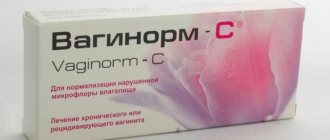According to research, vaginal discharge is as physiological as the production of saliva, sweat or tears. They perform certain functions in the body and are found in absolutely healthy women. Heavy vaginal discharge is completely normal and contains cervical mucus, epithelial cells, and 5 to 12 types of microorganisms (normal).
Normal vaginal discharge is acidic, which is possible due to the presence of lactobacilli. But under certain conditions, the nature and composition of the discharge may change. In this case, we can talk about pathological discharge, indicating diseases of the genitourinary system.
Discharge after menstruation
Vaginal discharge after menstruation can be physiological and pathological. Normally, postmenstrual discharge is dark brown in color. This is due to increased blood clotting at the end of menstruation and its slow release. Physiological secretions are odorless.
An unpleasant odor accompanying vaginal discharge before and after menstruation indicates the possible presence of chlamydia, ureaplasma, mycoplasma or genital herpes.
If discharge does not appear immediately after menstruation, but after a few days, then an uterine or ectopic pregnancy can be suspected. In this case, the woman needs to contact a gynecologist.
Discharge rate
The nature of mucous discharge from the vagina normally varies depending on the day of the menstrual cycle:
- In the first half of the menstrual cycle , i.e. period from the first day to the twelfth, the discharge has a translucent mucous character with a liquid consistency. A yellow or transparent tint may appear, as well as a slightly sour odor.
- During the period of ovulation , which falls in the middle of the cycle, the volume increases, reaching 4-5 ml per day. The mucus has a viscous consistency and a transparent or light beige color.
- From 15-18 days of the menstrual cycle , i.e. in its second phase, the volume of mucus from the female organs decreases again, the consistency resembles jelly or thin cream. They will be clear and slightly whitish or yellowish. As menstruation approaches, the consistency becomes thinner or nothing is released.
Normal discharge
Normal vaginal discharge comes in many varieties. This variety will depend on the woman’s age, sexual activity and hormonal status.
It is possible to determine which vaginal discharge is normal and which is pathological thanks to some general criteria:
- slightly sour smell or its complete absence;
- homogeneous thick consistency (liquid sour cream), lumps up to 3 mm are acceptable;
- transparent or with a white tint;
- the total amount of discharge does not exceed 1 to 4 ml per day.
Physiological discharge is never accompanied by itching in the vagina. However, when changing sexual partners, the amount of vaginal discharge may increase.
Changes in discharge during the cycle
The regular menstrual cycle is 21-35 days. This period is divided into three phases, each of which is characterized by certain features of the discharge.
The follicular phase lasts from days 1 to 12-14 (with a 28-day cycle). During this period, light leucorrhoea is observed. Discharge of uniform consistency, colorless or white or yellowish in color with a slight sour odor.
The ovulatory phase - days 13-15 - is the middle part of the menstrual cycle. This period is characterized by ovulation. Abundant discharge is noticed, which becomes liquid, stretchy, mucous, similar to egg white. They may have a beige or white tint.
With an established cycle, the second phase is a favorable period for conceiving a child only if the leucorrhoea is profuse and thin.
The luteal phase of the cycle occurs on days 14-28. There is less whiteness. They are transparent in color. The luteal phase transitions into menstruation.
Types of vaginal discharge
There are many types of vaginal discharge, which can have both physiological and pathological origins. If the discharge has an unpleasant odor, purulent consistency, or is accompanied by a burning sensation, pain or other symptoms of discomfort, you should immediately consult a doctor.
We answered in more detail below the question about what types of vaginal discharge there are.
Watery discharge
Watery vaginal discharge may indicate inflammation of the fallopian tubes or cervical erosion. This is due to the fact that when the fallopian tube is inflamed, the secretion of cells through the uterine cavity enters the vagina.
Normally, liquid vaginal discharge may occur in pregnant women. The appearance of vaginal discharge like water is not an independent sign of the disease, but signals the presence of a pathological process in the body.
Purulent discharge
Purulent vaginal discharge may indicate inflammatory diseases, such as bacterial vaginitis, salpingitis, cervicitis, as well as some sexually transmitted diseases (trichomoniasis).
The discharge becomes liquid or foamy, has an unpleasant odor and is yellow-green in color. They are often abundant.
Transparent selections
Transparent vaginal discharge accompanies the normal functioning of the genital organs. They are an indicator of cyclical changes in the body associated with the normal functioning of the ovaries.
Transparent mucous discharge from the vagina is a physiological fluid, which contains epithelial cells, lymph, mucus and microorganisms. Copious transparent vaginal discharge can become pathological only in girls under 10 years of age.
Mucus discharge
Mucous discharge from the vagina is normal in most cases; it is due to the nature of the uterine secretion. If vaginal discharge looks like snot, is accompanied by an unpleasant odor and is streaked with blood, then this may indicate cysts and erosions present in the body.
In addition, jelly-like vaginal discharge may indicate the presence of inflammatory diseases of the uterus and ovaries. Mucus discharge from the vagina mixed with blood can also occur during an ectopic pregnancy.
Bloody discharge
As a rule, small amounts of blood discharge from the vagina occur before and after menstruation. Also, spotting from the vagina may appear in women taking oral contraceptives in the first 2 months from the start of use.
If vaginal discharge with blood is not associated with the physiological cycle, it may be a manifestation of cervical cancer pathologies, endometriosis or advanced erosion. In this case, it is best to consult a gynecologist to find out the nature of such discharge.
White discharge
White vaginal discharge with a cheesy consistency almost always indicates candidiasis. At the beginning of the disease, the discharge of leucorrhoea from the vagina is small, but if left untreated, it can become profuse. Often, white, thick vaginal discharge is accompanied by a sharp sour odor, itching and pain when urinating.
Upon examination, the mucous membrane of the external genital organs is covered with a curdled or milky coating, which is easily removed.
Brown discharge
Brown vaginal discharge normally occurs at the end of the menstrual cycle and at the beginning of sexual activity. Pathological brown vaginal discharge occurs with thrush, chlamydia, trichomoniasis or inflammation of the vagina.
Brownish vaginal discharge is also observed when the menstrual cycle is disrupted.
Yellow discharge
If yellow vaginal discharge has a faint yellow tint and is not accompanied by discomfort, then this is normal.
If the vaginal discharge is yellow in color and has a rich hue and is accompanied by itching, pain or an unpleasant odor, then we can say that this is observed with inflammation of the uterine appendages and sexually transmitted infections. In addition, yellowish vaginal discharge is also observed with cervical erosions.
Black discharge
Most often, black discharge from the vagina can occur during inflammatory diseases or when using hormonal contraceptives.
Pink discharge
Normally, pink vaginal discharge may appear during ovulation. If pink discharge from the vagina is accompanied by discomfort in the lower abdomen, then doctors may suspect cervical erosion.
Faint pinkish vaginal discharge, aggravated by pain, may indicate various sexually transmitted diseases.
Dark discharge
Dark vaginal discharge normally occurs before, after and in the middle of the menstrual cycle. If the discharge is accompanied by abdominal pain or other discomfort, then cervical erosion, pelvic inflammation, or the presence of sexually transmitted diseases can be suspected.
Orange discharge
Orange vaginal discharge that appears after unprotected sex indicates infection with trichomoniasis or gonorrhea. If there is no sexual activity, such discharge may indicate bacterial vaginosis.
Gray discharge
Serous vaginal discharge is considered normal if it is not accompanied by pain in the lower abdomen, itching, or unpleasant odor. If gray vaginal discharge is accompanied by pain, then one may suspect the presence of infections such as ureaplasmosis or mycoplasmosis. Consultation with a gynecologist is necessary.
Foamy discharge
Foamy vaginal discharge can be caused by stress, nervous fatigue, or recent unprotected intercourse. Most often, foamy discharge is accompanied by trichomoniasis.
Discharge flakes
Flaky vaginal discharge is most common with vaginal candidiasis (thrush). They also have a characteristic white color and sour odor.
Brown discharge
Typically, brown vaginal discharge is considered normal only at the beginning and end of menstruation. In other cases, these are pathologies, the causes of which are determined in the laboratory.
Creamy discharge
Quite often, creamy vaginal discharge can indicate pregnancy, and if there is discomfort, it can indicate pathological diseases of the genital organs.
Colorless discharge
Most often, colorless vaginal discharge that is not accompanied by physical discomfort or odor is completely normal. If you are also concerned about discomfort in the genital area, you should consult a doctor.
Cloudy discharge
Cloudy vaginal discharge is most common with bacterial vaginosis and sexually transmitted diseases.
Sticky discharge
Sticky vaginal discharge may indicate the presence of thrush or other genitourinary infections in the body. One way or another, the situation requires medical intervention.
Light discharge
Light-colored vaginal discharge—white, transparent, or slightly tinged with pink or yellow—is normal. However, it is worth remembering that normally their number is minimal, and any discomfort, itching or burning in the vaginal or labia area indicates the presence of infections, which requires contacting a gynecologist.
Green discharge
Green vaginal discharge indicates an increased level of white blood cells. Greenish vaginal discharge, therefore, indicates bacterial inflammation of the uterus and its appendages.
Natural causes of mucous-like discharge in women
Sticky discharge is normal - it appears after sexual intercourse, as well as at some stages of the cycle. These leucorrhoea act as a protective barrier against infections, cleanse the vagina of foreign microorganisms, and moisturize the mucous membrane. Thus, the appearance of mucous discharge is considered normal if there are no foreign sensations in the perineal area.
Female discharge like snot before and after menstruation
The consistency of the secretion depends on the concentration of hormones. Sticky snot and mucus are a physiological phenomenon and are allowed both before and after menstruation.
At the very beginning of the cycle after menstruation, women often notice the production of sticky mucus, which may be brownish due to the admixture of blood. In the middle of the cycle, the fertile period begins, the level of the hormone estrogen increases. Due to changes in hormonal levels, leucorrhoea can become abundant and less viscous - favorable conditions are created for fertilization.
At the end of the cycle, the hormonal background changes and becomes stable. The amount of leucorrhoea decreases in volume, you can notice a mucous or transparent secretion, a few days before your period it may look like egg white.
Features of discharge during the cycle
Depending on the phase of the cycle, leucorrhoea may vary. After the end of your period, a small amount of sticky brown leucorrhoea is acceptable. During ovulation, estrogen thins the mucus. Before your period begins, you may notice sticky, stretchy mucus.
Probability of conception and pregnancy
If there is a delay in menstruation, and mucus without color appears instead, there is a possibility of pregnancy. During conception, it is possible that a small brownish or pink discharge may appear - this phenomenon is called implantation bleeding.
In the second trimester, a small amount of clear leucorrhoea indicates a normal pregnancy. If their number increases, you should make sure that there is no leakage of amniotic fluid - you need to contact an antenatal clinic.
In the last month of pregnancy, the appearance of copious secretions is often associated with the passage of a mucus plug; this sign signals the onset of labor.
Mucus discharge instead of menstruation
The appearance of mucus instead of menstruation is a sign of pregnancy, but there are other reasons why menstruation does not occur. Thus, a sudden change in climate or severe stress, inadequate sleep can affect its delay.
Other reasons for the absence of menstruation that are not related to conception are excess weight, poor diet, taking certain hormonal medications, and alcohol abuse.
After the baby is born
For a long time after childbirth, a woman develops bloody leucorrhoea. This is due to the fact that after placental abruption, the uterus must recover and shrink in size. The body is cleansed, and upon completion of recovery, the leucorrhoea becomes transparent. After discharge from the maternity hospital, you should independently monitor the characteristics of the discharge.
The time of uterine involution depends on how the birth went, as well as on the body. On average, the recovery process takes about 30 days, but sometimes pinkish leucorrhoea appears after 6 weeks.
A long recovery process is not always natural; if the discharge does not go away, you need to consult a doctor. The absence of lochia is also a reason to consult a gynecologist.
After operations
Often, operations of the reproductive organs cause the appearance of bloody mucus. After recovery, the leucorrhoea becomes mucous, indicating the healing of all damage. It is important that the mucus is odorless and that the woman is not bothered by pain or the appearance of discharge of an unnatural color. Otherwise, consultation with surgeons is required to check for complications.
Menopause
When menopause occurs, leucorrhoea, similar to snot, is not a symptom of pathology. At the same time, women should not have any extraneous sensations that cause discomfort. Subsequently, the amount of secretion decreases due to a decrease in the concentration of sex hormones.
Treatment of discharge
Many women practice self-treatment of vaginal discharge. But this may not only be ineffective, but also harmful in itself, since when douching with a soda solution or chamomile decoction, beneficial microorganisms are washed out of the vagina. Therefore, treatment for vaginal discharge should be prescribed and monitored by a doctor.
If pathological discharge appears, you must contact a gynecologist to diagnose the disease that caused it. After identifying the cause, the doctor will prescribe treatment for the underlying disease, as well as procedures aimed at restoring the vaginal microflora and increasing the body’s immunoresistance.
Detailed signs of pathological discharge
Discharge in women is called pathological if it is a symptom of inflammation, tumors of the genital organs and STIs (sexually transmitted infections). In a healthy woman, discharge cannot cause burning, discomfort, itching, irritation or other unpleasant sensations. A microflora smear will show the number of leukocytes within normal limits, not increased.
Symptoms of pathological discharge requiring urgent diagnosis and treatment:
- Discharge that is brown, pink, or bloody any time outside of your period.
- The usual amount of menstrual blood changes: it becomes less, more. Menstruation passes with pain or disappears completely.
- Copious discharge of white, green, yellow, dark shades, uncharacteristic of the menstrual cycle.
- Discharge accompanied by itching, abdominal pain and an unpleasant odor.
If streaks of blood and clots appear in the vaginal discharge, and the leucorrhoea begins to look like meat slop, you need to urgently contact a gynecologist, take smears, blood and urine tests, and do an ultrasound. These are ominous symptoms indicating a high probability of cancer.
It is important to understand that the cause of discharge may not necessarily be a disease of the reproductive system. They can also be caused by other types of pathologies that have no connection with the genital organs. But in any case, the examination should begin with a gynecologist.
Vaginal discharge in a child
Vaginal discharge in a child can be either a physiological process or a sign of a disease.
A girl should not experience vaginal discharge before puberty; it appears about a year before the start of menstruation. The causes of pathological discharge in children may be:
- diabetes;
- inflammation of the vagina;
- worms;
- upper respiratory tract diseases;
- antibiotic therapy;
- thrush;
- allergic reactions.
Vaginal discharge in adolescents who have sexual relations may indicate sexually transmitted diseases. Often the onset of sexual activity is normally accompanied by discharge that does not cause physical discomfort.
Discharge in newborns
Physiological vaginal discharge in newborns can occur in the first week of life during a hormonal crisis. This is due to the fact that their body gets rid of the mother’s hormones and begins to form its own hormonal background. If vaginal discharge in a baby is accompanied by pain or itching, you should immediately consult a doctor to determine the cause of these symptoms.
Causes of symptoms
The secretion that is secreted from the female vagina is involved in moisturizing the mucous membrane of the walls of the genital organ, and also protects against the entry of various pathogens and bacteria inside, while providing assistance to the body. Speaking about why mucus appears from the vagina, it is not necessarily the case that mucous discharge in women can signal the presence of any disease. The reasons for the development of such a symptom can be very diverse :
- Copious mucous discharge in women can occur due to sexual arousal.
- Depression and stressful situations.
- Sudden changes in weather or climate.
- Taking hormonal drugs.
- Allergic reaction.
- Failure to comply with intimate hygiene rules.
- Hormonal disorders during the menstrual cycle. As a rule, after and before critical days, the structure and amount of mucous discharge is very different.
- Pregnancy period, a large amount of estrogens, which is the reason for the quantitative and qualitative composition of leucorrhoea.
Causes of discharge
Basically, the causes of vaginal discharge are due to one of the physiological processes in the body, unless they are accompanied by itching, pain or an unpleasant odor. If they change their character and cause discomfort to the woman, then they are already talking about pathological discharge. They can occur with bacterial inflammation of the genital organs, erosion, polyps, polycystic disease, venereal and fungal diseases.
It is possible to reliably determine the reason why vaginal discharge suddenly changed its properties only by laboratory methods.
Features of female discharge with dangerous signs
Discharge is distinguished by consistency, abundance and color. These signs make it possible to determine the presence of a certain gynecological disease in the body.
- Natural discharge between periods has the consistency of colorless, odorless mucus. If they become yellow, green or cheesy and are accompanied by purulent discharge, then this is an alarming signal indicating an infection.
- Discharge that is dark, pinkish or mixed with blood indicates a hormonal imbalance in the body or erosion of the cervix.
- Brown or pink spotting is considered the most dangerous to a woman’s life, especially if it appears during pregnancy. You should consult a doctor immediately, especially if the discharge is accompanied by the following symptoms: headache and abdominal pain, rapid heartbeat, weakness and low blood pressure, thready pulse, profuse sweating, pale skin.
Many diseases, incl. and STDs are asymptomatic. There are discharges, but they are not pathological and look normal. If the disease occurs in a latent form, it is almost impossible to diagnose it independently due to the absence of characteristic manifestations. Pathology can be detected during a routine examination. To do this, a woman must be examined by a gynecologist at least 2 times a year and take a smear, which will determine the presence of hidden diseases at the initial stage.
Discharge from a cold
When you have a cold, vaginal discharge can become fungal in nature. This is due to the fact that hypothermia and viral diseases disrupt the balance of normal microflora. Most often, thrush can develop against the background of a cold. It is manifested by itching in the genital area and cheesy vaginal discharge.
If an inflammatory process in the ovaries begins during a cold, the discharge becomes abundant and may even contain streaks of blood.
Benign and malignant neoplasms
Bloody discharge appears when the mucous membrane of the vagina or vulva is injured, tumors form in the genitals, and areas where blood vessels are damaged become inflamed.
| Disease | Discharge color | Causes of pathology |
| Cervical erosion | Bloody discharge after sex, gynecological examination | Infections, injuries, hormonal changes |
| Uterine fibroids | Blood appears in mucous secretions, which has nothing to do with menstruation | Hormonal imbalance |
| Endometriosis | Discharge with brown streaks of blood appears | Hormonal imbalance, reflux of menstrual blood, etc. |
| Malignant neoplasms | Mucus streaked with blood is released | Not known |
A change in the smell and color of the discharge is a sign of inflammatory processes. The reasons may be:
- surgical intervention;
- decreased immunity;
- violation of vaginal microflora;
- hypothermia;
- infection during sex.
Pathological bleeding is not associated with cyclical processes and continues after menstruation.
Allocations change in the following cases:
| Type of disease | Affected areas | Discharge |
| Inflammatory diseases | Internal and external genitalia | Mucous leucorrhoea of a yellow or green hue with an unpleasant odor |
| Bacterial vaginosis | Vaginal microflora is disrupted | White-gray discharge with a fishy odor |
| Candidiasis | Vagina, cervix | Curdled discharge |
| Venereal diseases | Vagina, cervix, urethra, uterus and appendages | Different nature of discharge depending on the causative agent of the disease |
A diagnosis can only be made after an examination by a gynecologist.
Discharge during menopause
Vaginal discharge during menopause is not normal. They may indicate inflammatory diseases, tumors and neoplasms in the breast and genitals. As a rule, discharge during menopause can be in the form of exudate, which indicates inflammation, or transudate - in diseases of a non-inflammatory nature.
The exudate has a mucous consistency and contains protein. It may be catarrhal, purulent, serous, fibrinous or hemorrhagic. The consistency of the transudate is liquid and does not contain protein. It is either straw-colored or transparent with an admixture of blood and other body fluids.
Mucous discharge is normal
Physiological vaginal secretions play an important role in the female body. Leucorrhoea contains mucus, which is produced by the glands of the cervix and vulva. Mucus contains fluid that is secreted by blood and lymphatic vessels.
Signs of normal vaginal discharge:
- Color . It should be transparent with a slightly white or beige tint.
- No smell . A slightly acidic aroma may be detected.
- Consistency . Fluctuates between liquid and viscous discharge.
- Volume. No more than a teaspoon is released per day.
Before menstruation, after intercourse and during sexual arousal, the volume of discharge increases.
Options for where inflammation develops
Discharge in the form of jelly of an atypical color or smell indicates not only problems in the vagina. The following cases may occur:
- the most common inflammatory processes - the culprits of leucorrhoea - include diseases of the vagina, including its dysbiosis;
- Possible problems in the fallopian tubes. During the inflammatory process, a process of narrowing of the lumen of the tube due to edema is observed. The contents of the tubes unevenly enter the uterus, and then are released into the vagina in portions;
- if the endometrial cells of the uterus are affected, leucorrhoea may also appear;
- when the cervical canal is inflamed, glandular cells excessively produce mucus, and the volume of vaginal discharge increases significantly;
- It is possible that vestibular leucorrhoea may form when the vestibule of the vagina does not function properly.
In general, in adolescence, more than half of all complaints about leucorrhoea are explained by disruptions not in the sexual sphere, but, for example, in the endocrine system, or allergic reactions. Only a third of all patients in this age group have problems with gynecology, and in most cases due to infections.
During menopause, vaginal discharge changes in character due to atrophy of the genital mucosa, but oncological pathologies are no longer excluded.
Natural discharge can suddenly change to heavy and even purulent if a foreign body remains in the vagina for a long time. For example, a hygienic tampon (gynecologists allow it to remain in a woman’s body for no more than 8 hours) or a vaginal ring to protect against unwanted pregnancy.
If a woman is generally healthy, then the initial imbalance in the vaginal microflora levels out on its own, and soon the discharge takes on its usual appearance. But if infections occur, it is no longer possible to do without qualified medical care.
When secretion is normal
The secretion of a healthy woman is characterized by the following signs:
- its volume does not exceed five milliliters per day (one teaspoon);
- it should have a whitish, transparent or milky tint and a uniform texture;
- the structure of the secretion should be thick, viscous or mucous and have small compactions up to 4 mm;
- the discharge should not be accompanied by an odor;
- White discharge in women should not be accompanied by redness, itching or swelling.
If a woman's white, odorless discharge meets these criteria, then there is no need to worry. In addition, leucorrhoea may not be a pathological condition even in the case of natural causes that characterize the woman’s condition.
Discharge like snot during pregnancy
When a fertilized egg is implanted into the endometrium of the uterus and the placenta is formed, a complete restructuring of the background of sex hormones occurs in the woman’s body. Therefore, discharge, like snot, during pregnancy is not uncommon.
All the basic requirements for what a normal vaginal secretion should be in a pregnant woman are the same as during the period outside of gestation. The discharge, although it may be viscous, should remain clear or slightly whitish, odorless and in small quantities.
Pregnancy itself places an increased burden on a woman’s body, including the immune system. Therefore, the development of various infectious processes in the vagina and other female genital organs during this period is very important. As a result of such diseases, complaints arise about the appearance of viscous discharge, which poses a danger to the fetus and the woman.
Treatment of this condition, in addition to general hygiene procedures, is difficult due to the potential harm of most pharmacological agents on the unborn child, especially in the first trimester of pregnancy.
- This fact dictates the need to examine a woman before conception in order to exclude chronic diseases.
Tags: gynecology
- Green discharge in women - causes and treatment, medications
- Monocytes are elevated - what does this mean, what does it mean?
- Reduced neutrophils in a child or adult, which...
- The left side hurts under the ribs on the side / front - what...
- Vulvitis - symptoms and treatment in women, medications
- Symptoms of thyroid disease in women
Why do women produce mucus?
All girls and women have mucous discharge in a certain amount. In addition to climate and living conditions, their manifestation is influenced by:
- menstruation;
- contraceptives;
- the period before and after childbirth;
- change of partner;
- menopause period.
During pregnancy
Abundant mucous discharge during early pregnancy occurs due to changes in hormonal levels. This occurs due to increased blood supply to the genital organs. The structure of such mucus is transparent, watery or completely liquid. An even greater increase in the production of mucous structures occurs in later stages of pregnancy. This is not a pathology unless very thin discharge occurs just before birth. This process indicates the danger of premature birth.
After childbirth
The discharge accompanies the woman even after the birth of the baby. At first they have blood admixtures, but after 7-8 weeks they acquire a liquid and transparent structure, as they did before pregnancy. During lactation, female secretions such as mucus are scanty, so the appearance of an unpleasant odor, a sharp change in color, accompanied by swelling or itching, may indicate a pathology. In this case, to avoid complications, it is better to immediately contact a gynecologist.
- White discharge in the corners of the eyes: causes and treatment
- White snot in a child and an adult
- Reasons for the appearance of brown discharge after menstruation - how to distinguish normal from pathology
After menstruation
Mucous discharge in all women after the end of menstruation is a normal process if it has a transparent, liquid or jelly-like structure. The main thing is that there should be no unpleasant odor, pain or burning or itching sensation, otherwise this is already evidence of improper functioning of the genital organs. This discharge can be caused by an infection or a disruption of the menstrual cycle. Although if the symptoms are accompanied by pain, then it is possible that this is inflammation of the urethra.
What is mucus in stool
The wisely designed human body constantly secretes mucus to protect tissues and organs. An oily, jelly-like substance of white or transparent color is formed by the secretion produced by the intestinal glands. Part of it consists of epithelial cells, leukocytes on the surface of the mucous membrane. This secret plays an important role:
- protects against the influence of toxic components of feces;
- protects the intestinal lining from the mechanical effects of coarse food fibers;
- prevents chronic constipation due to difficult passage of stool.
The adult body constantly produces and eliminates viscous contents - this is normal. Thanks to mucus, stool can easily move through the intestinal tract and exit through the anus. With inflammatory changes in the intestines, serious problems arise with the release of lubrication. As a result:
- in the absence of cracks, damage to the mucous membrane, bleeding, and development of hemorrhoids;
- Serious pathologies are possible with excessive secretion production;
- A change in the color of the discharge indicates the presence of problems that require treatment.
What does it look like
The norm is that transparent mucus in the stool of an adult comes out in small quantities and consists of dead epithelial cells. With pathological lesions of the intestines, changes in the stomach, a protective reaction to the irritation process occurs. A lubricant begins to be intensively produced, protecting the mucous membrane and helping to remove foreign substances and pathogenic microorganisms.
Depending on the pathology, the viscous contents may differ in color and shape:
- white or transparent – problems of the distal intestines;
- yellow – provoked by antibiotics, polyps, hemorrhoids;
- grayish flakes on the surface of the stool are evidence of damage to the rectum and descending colon;
- green – bacterial infection;
- pink – processes with the release of pus;
- small flakes mixed with feces - problems of the small intestine;
- with an admixture of blood - ulcers, cracks, hemorrhagic inflammations;
- black – cancerous tumors.
Causes
There are many reasons for the appearance of mucus in the stool of an adult. Some of them are related to lifestyle, for others the provoking factor is diseases. Typical reasons for the formation of mucous discharge:
- poor quality water;
- the presence of coarse dietary fiber;
- prolonged fasting;
- hypothermia of the pelvic organs;
- taking medications;
- swimming in a pond with cold water;
- alcohol abuse;
- frequent dieting;
- stressful situations;
- eating unwashed vegetables and fruits
- smoking;
- unbalanced diet.
White mucus in stool
What causes white, jelly-like discharge to appear in an adult? These symptoms in stool indicate the presence of stomach diseases and intestinal pathologies. The reasons for the appearance of symptoms are:
- inflammation of the rectum, as well as the sigmoid and descending;
- protective reaction to irritation by pathogenic organisms;
- fungal infection of the anus;
- poor nutrition;
- lack of beneficial microorganisms – dysbacteriosis.
Mucus in the stool of an adult, white in color, is formed as a result of:
- bacterial infection of anal fissures;
- inflammatory diseases of the large intestine;
- irritation of the intestinal walls due to allergic reactions, lactose intolerance, atopic dermatitis;
- damage to the intestinal mucosa;
- use of antibacterial drugs;
- inflammation of the rectal mucosa;
- candidiasis;
- disturbances of normal microflora;
- diseases of the pancreas, liver, gall bladder.
When a patient comes out of the anus instead of feces with a viscous secretion that resembles snot or mucus, this means that the person is unable to retain the contents of the rectum. In this condition, pain in the lower abdomen and fever are observed. They provoke the appearance of the following symptoms:
- prolonged constipation;
- intestinal obstruction;
- helminthic infestations;
- volvulus;
- bacterial infections;
- rectal ulcer;
- neoplasms;
- polyps;
- foreign object in the intestine.
With blood
A very serious situation - the release of bloody viscous contents. This is a sign of dangerous diseases. Mucus with blood in the stool of an adult has specific features in appearance, depending on the diagnosis. Experts note:
- pathological impurities - veins with lumps of mucus - Crohn's disease, oncology;
- inclusions of blood clots in the stool indicate bleeding due to hemorrhoids, rectal cancer (mucus can be found on toilet paper after defecation);
- jelly-like mass – proctitis, polyps, stomach ulcer.
It is urgent to undergo an examination and begin treatment when mucous discharge with blood first appears during bowel movements. Symptoms, depending on the nature of secretion, indicate pathologies:
- the presence of an admixture of mucus with blood of a watery consistency - respiratory, intestinal infection;
- scarlet mucous contents – liver cirrhosis, intestinal varicose veins, ulcer or stomach cancer;
- copious discharge in the stool – rectal diverticulosis, ischemic colitis.
Yellow slime
When an adult has stool with mucus, the yellow color of the discharge may indicate the presence of polyps, symptoms of hemorrhoids. The viscous secretion protects the mucous membranes from damage. The appearance of stool with yellow mucus indicates the following problems:
- bacterial inflammation of the intestines;
- impaired absorption of products;
- taking antibiotics that affect healthy intestinal microflora;
- hypothermia of the pelvic area;
- intestinal infections;
- cancerous tumors.
Transparent slime
There are many reasons for the appearance of jelly-like discharge in the stool of an adult. Mucus that looks like a transparent dense film is evidence of membranous colitis. Viscous contents may envelop feces or be in the form of mucous impurities. Provoke the phenomenon:
- smoking;
- taking antibiotics;
- drinking coffee;
- remedies for flatulence, gases;
- non-steroidal anti-inflammatory drugs;
- haemorrhoids;
- infectious intestinal diseases;
- spastic constipation;
- colitis;
- colds with runny nose.
Pink slime
The formation of pink mucous discharge in the stool of an adult indicates the emergence of serious problems. The situation requires accurate diagnosis and immediate treatment. Pink mucus during bowel movements may indicate the presence of:
- liver cirrhosis;
- stomach ulcers;
- allergic colitis;
- Crohn's disease;
- varicose veins in the intestines;
- nonspecific ulcerative colitis.
- colon polyp;
- enterocolitis;
- intestinal diverticulum;
- capillary bleeding in the upper parts of the colon.
Black slime
Feces and mucous secretions may turn black after taking medications and vitamins. You need to know that the appearance of such jelly-like discharge in an adult can be a dangerous symptom. An urgent visit to the doctor and tests will clarify the situation. A change in the color of mucus in the stool is associated with a strong darkening of the blood that accompanies pathologies:
- bleeding in the small intestine, esophagus, stomach;
- growth of malignant neoplasm.
Brown slime
The appearance of brown mucus in the stool of an adult may indicate insufficient pancreatic function and hypotonicity of the colon. Liquid discharge accompanies intestinal dysbiosis.
These conditions require the intervention of a gastroenterologist. Doctors note that brown discharge does not always indicate dangerous syndromes. There is no need to worry if the cause is mucous secretion from the nose entering the esophagus and intestines.
This happens in diseases accompanied by a runny nose:
- rhinitis;
- allergy;
- acute respiratory disease;
- polyps;
- flu.
When such a delicate problem arises, it is better for an adult to first consult a therapist. The doctor will conduct a survey, find out the nature of the mucus, the consistency of stool, features of lifestyle and nutrition. Important issues include taking hormonal medications, antibiotics, duration of illness, symptoms. Based on the results of the examination, a referral will be given for consultation with specialists:
- gastroenterologist;
- infectious disease specialist;
- proctologist;
- surgeon;
- oncologist.
To establish an accurate method of treating diseases, correct diagnosis is necessary. The study of pathology requires special research. Necessary:
- take stool tests for the presence of fungi, viruses, bacteria, parasites, occult blood, leukocytes;
- study the composition of urine;
- do a biochemical blood test;
- perform a colonoscopy - observation of intestinal pathologies using a special probe;
- do an ultrasound examination of organs;
- conduct a computed tomography scan to determine abnormalities in the stomach and intestines.
Treatment
After correct diagnosis, the doctor prescribes treatment for the adult to prevent the appearance of viscous contents in the stool. One of the first measures is a diet that excludes the consumption of coarse fibers, suggesting a balanced diet. The prescription of the medicine depends on the disease:
- treatment of hemorrhoids - suppositories, tablets to relieve inflammation, stop bleeding;
- for irritable bowels - antispasmodics, medications for constipation;
- to get rid of parasites - tablets for their removal.
If the cause of the appearance of mucous contents is oncology, radiation treatment and chemotherapy are prescribed. Medications help cope with the problem in adults.
Natural excretion factors: when not to worry
Non-hazardous factors such as:
- postpartum and pregnancy period;
- a certain phase of the cycle;
- use of vaginal medications;
- hormone therapy;
- taking contraceptives;
- sudden climate change, stress, the state of the body as a whole.
Odorless secretion can be abundant or scanty, dense or watery. For example, during the period of ovulation or after sexual intercourse, a woman may notice more abundant secretion than leucorrhoea associated with the onset of menopause or inappropriate hygiene products for the intimate area. But watery discharge in a woman is more often noticed before menstruation or during the period when the oocyte leaves the follicle. If natural leucorrhoea lasts no more than three to five days, it does not cause irritation of the mucous membranes and does not cause discomfort, then it does not require any treatment. What cannot be said about pathological discharge.
White discharge in women before menstruation and during ovulation
Leucorrhoea itself is normal. They are the result of the functioning of the reproductive system and the removal of unnecessary flora and bacteria from the body.
Every girl who has reached puberty should have discharge indicating the health of her reproductive system.
Olga Zorina
Pregnancy and childbirth, Gynecologist, Gynecologist-endocrinologist
Leucorrhoea helps cleanse the genitals of mucus and facilitates the process during sexual intercourse. Physiologically, female hormones – progesterone and estrogens – stimulate the appearance of leucorrhoea. After the end of menstruation, the amount of these hormones begins to increase, which leads to an increase in discharge. Moreover, their peak comes on days 12-14 of the cycle, when ovulation occurs.
As a rule, the signs of ovulation in a woman, sensations and discharge are the same. In addition to an increase in basal temperature, pain in the lower abdomen and breast enlargement, a woman notices changes in the nature of the mucus. The secretion acquires a transparent, elastic structure, reminiscent of egg white. It stretches easily between the thumb and index finger, which indicates the ideal period for conception.
The duration of increased leucorrhoea is about three days.
The volume of cervical mucus also increases a couple of days before the onset of menstruation. This occurs due to the high concentration of estrogen. The consistency may become creamy.
Table 2. Type of discharge during the cycle
When should you be concerned?
The development of pathological processes should be suspected if the smell of mucus becomes sharp, sour and unpleasant. It may also resemble the smell of rotten fish. Such manifestations are characteristic of bacterial vaginitis or other sexually transmitted diseases. With genital infections, transparent, stretchy mucous discharge in men may also appear, so representatives of the stronger sex in this case will also need an urgent consultation with a doctor.
If heavy discharge changes color and becomes yellowish-green or deep yellow, sometimes the lower abdomen hurts, this also indicates the development of unpleasant diseases. Even if pain in the lower abdomen appears rarely, but the color of the mucus has changed dramatically, it is better to consult a doctor.
If a woman after forty years has very abundant watery discharge or mucus like jelly, this should also be alarming. The doctor will be able to determine whether the discharge is like jelly, whether it is a pathology or the norm, after examination and testing.
The mucous membranes gradually change their character during thrush - they become white and cheesy. In this case, discomfort, itching, and periodic burning develop. In this case, the use of antifungal drugs will be required. It is quite possible that your sexual partner will also have to undergo such therapy.
In any period other than menstruation, a woman should be concerned about why there is discharge mixed with blood. This may be evidence of dangerous diseases.
Thus, if for a long time the daily amount of mucus exceeds the volume of one teaspoon, if the color of the secretions changes to yellow, green, brown or red and a bad odor appears, you must definitely visit a doctor. Symptoms that should alert you are also pain in the lower abdomen, itching and redness of the genitals, and increased body temperature.
The importance of maintaining intimate hygiene when there is heavy mucous discharge
Normal discharge is not dangerous. But if a woman does not adhere to basic rules of intimate hygiene, the mucus accumulated on the genitals can become an ideal place for the proliferation of pathogenic microflora. Therefore, it is necessary to devote time to hygiene procedures every day.
Intimate hygiene with heavy mucous discharge is very important
Washing gels "Ginocomfort" for daily hygiene of the intimate area effectively cleanse the female genital organs of mucous secretions without disturbing the vaginal microflora. The line of products for daily intimate hygiene includes several gel options, so you can choose the product that best suits you based on the action of its active ingredients.
The gels contain ingredients such as panthenol, bisabolol, sodium lactate, tea tree oil, lactic acid, chamomile extract, etc.
The use of Ginocomfort washing gels ensures the maintenance of normal vaginal microflora, helps fight the proliferation of pathogenic microorganisms, and has anti-inflammatory and tonic effects.
If a woman experiences a reduction in vaginal mucous discharge caused by stress or menopause, using a cleansing gel helps to further moisturize the vagina. All products in the line were created by specialists from the pharmaceutical company VERTEX and have the necessary documents. Sources:
- Hormonal status and vaginal microbiocenosis. Dobrokhotova Yu. E., Zatikyan N. G. // Obstetrics, gynecology, reproduction. - 2008. - 2 (2): pp. 7-9.
- Innate immunity of the female reproductive tract and its hormonal regulation (mini-review). Lebedeva O. P., Kalutsky P. V., Pakhomov S. P., Churnusov M. I., Karpov P. A. // Scientific bulletins of Belgorod State University. Medicine, pharmacy. - 2009. 12 (67). -WITH. 25-31.
- Normal microflora of the female genitourinary tract and drugs for its correction. Kocherovets V.I., Bunyatyan N.D. // M.: Publishing house "AKTEON". - 2011. - P. 72.
- https://cyberleninka.ru/article/n/mikroekologiya-vlagalischa-zhenschin-s-nespetsificheskimi-vospalit…
- https://cyberleninka.ru/article/n/sovremennye-predstavleniya-o-mehanizmah-razvitiya-disbioza-vlagali…
- https://cyberleninka.ru/article/n/vaginalnye-vydeleniya-prichiny-algoritm-vedeniya-patsientok-i-sovr…
White discharge with a sour odor
A sour, not pungent odor of secretion is normal in many cases. The largest component of leucorrhoea is due to lactobacilli - a large group of fermented milk bacteria that determine the acidity of the intravaginal environment. Its pH averages 3.8-4.4, which corresponds to a slightly acidic reaction.
Lactobacilli form lactic acid during their life processes. It is necessary in order to:
- inhibit the growth of opportunistic fungi in the vagina;
- prevent bacteria from penetrating deep into the mucous epithelium;
- regulate the fertilization process, since conception occurs only when there is a sufficient amount of sperm neutralized by vaginal leucorrhoea (a sufficient volume of ejaculate for this is an indirect indicator of a man’s general health).
Therefore, a slight sour smell may be a variant of the norm, but it is not present in all women, as it is a purely individual characteristic.
Prevention of genital diseases
To prevent the occurrence of various diseases of the reproductive system, you first need to adhere to the rules of personal hygiene. It is recommended to use special intimate hygiene products for washing. They have a composition that is gentle on the vaginal microflora. If they are unavailable, it is best to use regular baby soap.
https://www.youtube.com/watch?v=3yHTPrCtm2w
It is strictly forbidden to use other people’s hygiene items, or give your personal belongings to anyone. You cannot take someone else's underwear and towels. A balanced diet, the absence of bad habits and a healthy lifestyle help maintain the health of a woman’s genital organs.
Treatment at home
How to cure leucorrhoea? Treatment of discharge in women at home must be approached using comprehensive methods. Both traditional medicine and drug treatment are used together with correction of one’s diet and lifestyle.
Normalization of nutrition
The first step in how to treat discharge in women at home is to normalize your diet. It is necessary to exclude fatty foods and canned foods. During the treatment period, you should rely on fresh juices from celery and carrots, parsley, spinach and sorrel. The diet should include strawberries, blueberries, viburnum berries and barberries.
Hygiene of intimate places
Compliance with the rules of genital hygiene will help normalize the condition and prevent many women's problems. It is necessary to maintain the natural microflora of the vagina, which in itself can protect against many bacteria and fungi. You should wash twice a day (no more), using special products for the hygiene of intimate places (it’s good if the composition contains lactic acid).
Traditional medicine recommendations:
- Drink fresh juices from carrots, celery, spinach, other greens and green vegetables.
- Drink plain water with lemon juice.
- Rinse the external genitalia in warm water. You need to fill a basin with water and sit there for about 20 minutes.
- You can also make warm baths with pine or pine extracts added to the water. To prepare the extract, you need to pour three liters of water into 150 grams of dry pine. Boil for 40 minutes over low heat, strain.
- If the discharge is heavy (as well as during painful periods), you can drink ordinary nettle juice three times a day in the amount of a dessert spoon.
The following tools are also used:
- Pour a tablespoon of dried blueberry leaves into a glass of boiling water. Boil for 15 minutes in a water bath, cool and strain the broth, douche the vagina before bed.
- You can add two liters of boiling water to three tablespoons of dry St. John's wort. Boil for thirty minutes over low heat, cool and strain through cheesecloth, use for douching twice a day.
- Add a mug of boiling water to a tablespoon of immortal sandstone flowers. Cook for 10 minutes, leave for another 30 minutes. Take the decoction 50 ml orally before meals.
Before starting treatment, it is necessary to consult a doctor and follow his recommendations.
How douching can help?
The therapeutic effect for leucorrhoea of various types can be achieved if douching is done periodically. The material already indicates several decoctions that are suitable for these purposes. You can also use a decoction of dry mistletoe leaves for douching (pour 500 ml of water over a large spoonful of leaves, cook for 15 minutes, cool and strain).
Oak bark
For discharge, oak bark is excellent as a decoction for vaginal douching. Pour a liter of boiling water into a tablespoon of dry bark and cook for 20 minutes. Use by straining when the broth has cooled well.
Types of leucorrhoea
The discharge can be not only white, but also yellowish, greenish or creamy. There is nothing to worry about if they disappear quickly and do not cause pain. They occur against the background of excess production of the hormone progesterone. In gynecology, there are several main types of leucorrhoea:
- Abundant. White, strong discharge before menstruation is due to hormonal imbalance in the body. The norm is odorless mucus that does not lead to itching in the genital area. If you notice an unpleasant odor or traces of blood, you should immediately seek medical help.
- Sudden and significant increase in volume. This symptom often characterizes cervical erosion. But the disease can also be accompanied by bleeding after a gynecological examination or sexual intercourse.
- Liquid or thick. The appearance of thick leucorrhoea indicates an increased level of sugar in the blood or infection with helminths. This negative phenomenon is often caused by an unbalanced diet, following strict diets or taking contraceptives. Inflammation of the cervix is often diagnosed.
- Unscented or with smell. Only odorless leucorrhoea is considered the norm. If they give off an unpleasant or foul aroma, then you should consult a gynecologist.
- With bloody traces. Foamy or bloody leucorrhoea indicates the development of a serious pathology.
Experts warn that normally, after the appearance of leucorrhoea, menstruation occurs within 2-3 days. Women should monitor their quantity and composition, since any even minimal changes are an alarming sign indicating problems in the body.
Is it possible to determine the disease by the color of the discharge?
Unfortunately, there can be over 100 reasons that cause a change in the color and nature of the discharge; based on the external description of the discharge, not a single gynecologist can establish a diagnosis without laboratory diagnostics. Theoretically, only abundant, strong white curd-like discharge in girls and women can be an unmistakable diagnosis of vaginal candidiasis. However, thrush is often combined with other sexually transmitted infections, so only smear tests and bacterial culture, as well as tests for STIs, can determine the true cause of changes in a woman’s discharge. The color of the discharge can only give a little hint in which direction the research should be carried out more thoroughly:
- Transparent , foaming leucorrhoea can be a symptom of chlamydia in women.
- A gray shade of leucorrhoea with a characteristic fishy odor, most often occurs with gardnerellosis and bacterial vaginosis.
- Greenish discharge - discharge with this tint indicates a purulent process, since a large number of leukocytes give the discharge a green color. The stronger the inflammatory process, the more leukocytes, and, accordingly, the more green tint the discharge has.
- Yellow discharge - this may be one of the symptoms of trichomoniasis, since inflammation in trichomoniasis is most often localized in the vagina, where the concentration of leukocytes is lower.
- White discharge in girls can either be a symptom of thrush or be normal. Since with a mild degree of vaginal candidiasis there may not be significant itching and burning, only occasionally and slightly, therefore, if more abundant, too white, thick, curdled discharge appears, you should visit a gynecologist and find out whether it is thrush or not.
However, the color of the leucorrhoea should not be unequivocally regarded as a diagnosis of the disease; only tests can establish an accurate diagnosis for pathological discharge.
Discharge in pregnant women
Pregnancy is an exciting and worrying stage of life for a woman. During this period, a number of changes occur in the body, which are extremely important to monitor closely. Uncharacteristic vaginal secretions can be either normal or a sign of serious danger. Only with a timely response to pathological processes will it be possible to save the fetus.
Immediately after successful fertilization, the amount of normal secretion of a transparent color increases significantly. The mucus becomes thicker. Often, pregnant women experience jelly-like discharge. Such changes are not cause for concern and are considered a natural reaction of the body to hormonal fluctuations.
A signal to contact a gynecologist is leucorrhoea with blood streaks. Such symptoms indicate an increased risk of spontaneous miscarriage and possible ectopic pregnancy.
Thick, jelly-like discharge that turns yellow in color is also a concern. Often they signal the penetration of infection into the genitourinary system. In order not to harm the growing body, you need to immediately begin therapy, which is carried out under strict medical supervision.
Vaginal secretions acquire a thick consistency in the second trimester. It indicates a healthy pregnancy. If bloody inclusions are noted in it, then the woman is indicated for urgent hospitalization. The presence of blood in the leucorrhoea is a harbinger of premature birth.
Discoloration of the secretion in a brown color is considered acceptable only in recent weeks. Such changes are caused by minor damage to the cervix. However, in this case it is also recommended to consult a doctor.
Treatment methods and prevention
Normal vaginal mucus discharge should not bother a woman. In this case, the girl should only adhere to the general rules of intimate hygiene. To do this, the genital area must be washed with plain water twice a day, and underwear changed every day. It is recommended to give preference to clothes made from natural fabrics. If a woman uses panty liners, then it is best to choose hygiene products without various fragrances and fragrances, as they can cause microflora disruption.
If the protein mucus begins to increase in quantity or acquires an unhealthy color or smell, you should consult a gynecologist. Treatment will depend on the specific disease and its stage, which served as a provoking factor for changes in the composition of the secretion. The main condition here is not to delay contacting a doctor, since some diseases are dangerous to a woman’s health, some of them can even lead to infertility and death.
If uterine or vaginal discharge is caused by a fungal infection, then most often special creams or gels that are placed in the vagina are used for treatment. For bacterial vaginosis, the vagina is treated with homogeneous ointments made on the basis of antibiotics. Many vaginal infections and other diseases of the internal genital organs in women can be prevented by applying simple preventive measures :
- Always adhere to simple rules of intimate hygiene, and also regularly wash the labia majora using gentle soap and plain warm water.
- It is recommended to limit the use of scented hygiene products for intimate hygiene.
- Wear underwear made from cotton fabrics and avoid panties that are too tight.
- Use a condom during sexual intercourse, and be sure to wash yourself after it.
A woman’s body is designed in such a way that, in addition to monthly menstruation, clear mucus from the vagina can be observed every day, where thick whitish pieces may also be present. This is basically what leucorrhoea looks like when the genital organs are functioning normally. There is no need to worry about this, especially if all the rules of prevention are followed.
What to do if the nature of the discharge changes?
Many ailments, especially of the genital area, are often virtually asymptomatic, which is even more dangerous due to the lack of timely treatment. Changes in the nature of discharge are clear signs of the presence of certain health problems. Of course, it is necessary to immediately exclude the natural nature of such a phenomenon (pregnancy, menstruation, ovulation, menopause, etc.).
If you cannot find the cause on your own, you should definitely seek advice from a gynecologist. At the appointment, you need to talk in detail about the color, consistency and how the discharge smells. As a rule, such information helps to significantly narrow the list of necessary diagnostic measures, because certain diseases are characterized by specific symptoms. After taking tests, the doctor will tell you exactly the cause of changes in vaginal discharge and, if necessary, prescribe appropriate treatment.











